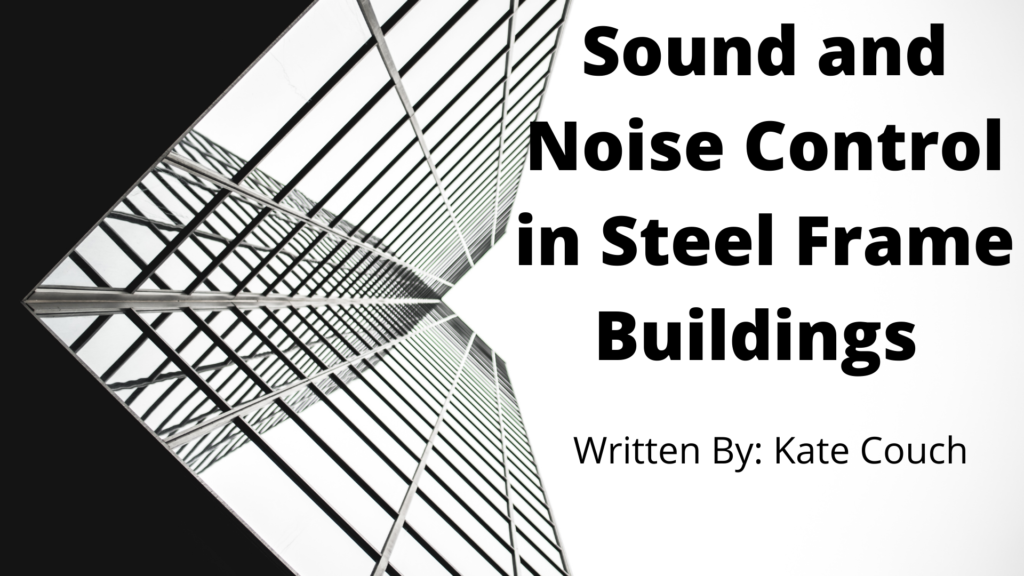Sound and Noice Control in Steel Frame Buildings

Photo and graphics by Kate Couch with Canva
Written By: Kate Couch with inspiration from American Institute of Steel construction’s article: Sound and Noise Control in Steel Frame Buildings.
At AV Bend we deal with a lot of commercial customers. People trying to design sound solutions for their commercial space. But one thing in AV that frequently flies under the radar is sound isolation in steel-frame and metal buildings. With more corporate offices being built similar to homes the industrial-type buildings are left by the wayside. But they still exist and lots of them still need proper acoustical treatment. So that poses the question: how do you treat a mental space? Ironically enough that question isn’t just for Audio Visual. Owner of AV Bend Tony Sprando has a son who owns a 1981 VW Rabbit, which until the other day was extremely loud. After some thought, they decided to line the interior with, Dynamat 11102 Dynaliner a thick self-adhesive sound deadener. This reduced the noise of the car by over 50% and was a simple and cheap fix for the sound metal problem. The fact that metal is such a loud material realy can affect multiple different areas.
Sound and noise control with metal and steel frame buildings begins in architecture. When an architect is designing these buildings (which frequently are schools warehouses and studios) they take certain design styles into account when using these materials. Taking the principle of acoustic comfort, which is what materials a designer uses, they will combine the louder more reflective materials such as metal with more sound-absorbent ones like wood. The sound absorbency of a material is referred to as its sound transmission class. This reduces how much sound is bouncing off of the walls. In some cases, something called flanking transmission happens when sound travels through walls and ceilings. So in addition to adding more of those materials that absorb sound, they also tend to make thicker walls with heavier-set insulation which decreases the sound travel or flanking transmission from room to room. Stud size and spacing, as well as the thickness of the walls, will all determine how much sound blockage and absorption there is. The more layers in a wall the less sound travel.
How sound travels is a science and this is something that architects also have to keep in mind. In addition to what materials they use and how much materials they use, how they placed these materials in the design of the building will also heavily affect sound travel. Architects that are dealing with louder materials like metal will frequently design a more acoustically quiet architectural design. Placing walls and ceilings strategically so the sound travels in a quieter way. But in order to completely do an architectural acoustical treatment, you need to take both materials and design into account. For example, how you place the walls and ceilings can dampen the sound of traveling voices but not hard sole shoes on tile metal or wood floors. Shoes can really drive up the decibel count of space. This is called Impact Insulation Class or IIC. This is why it’s important to also consider the materials used. Adding things like carpet the hallways that may need to be quieter.
After the architect designs a building with noise control and acoustical treatment in mind then a company like AV Bend comes in. This is when the decoration design and additional things we can add to the building come in hand. If things like wall thickness and materials didn’t do the job we can then take our acoustical treatment plans that we use for other commercial spaces into metal frame buildings. We also consider what is happening in the room. Taking into account the frequency of those sounds to design something custom. Adding foam wall panels considering certain types of furniture and its placement. All the way down to what is hung on the walls and where a local AV company we’ll take the design of the building and treat it for its specific noise issues.
If you have a metal-framed building for your corporate office consider using a local company like AV Bend to treat your sound issues.
*This article is Tony Sprando of AV Bends intellectual property. To use or reference this article please contact: Tony@avbend.com*
To know more about Tony and his professional profile see these:
https://www.linkedin.com/in/tonysprando/
https://www.ravepubs.com/author/tsprando/
To know more about Kate and her professional profile see these:
https://www.linkedin.com/in/kate-couch-a7318220a/
https://k8couch.wixsite.com/katecouch

